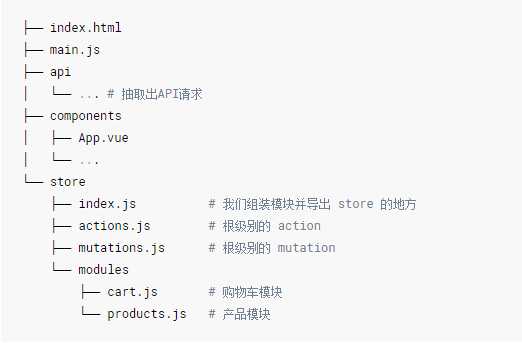标签:基础 render 项目 stat 更新 命名 str lan 常量
VUEX: https://vuex.vuejs.org,官方文档先仔细看一遍,否则基础的东西不知道看下面的内容会吃力
关于vuex的使用场景,先抄官网一段话:
虽然 Vuex 可以帮助我们管理共享状态,但也附带了更多的概念和框架。这需要对短期和长期效益进行权衡。
如果您不打算开发大型单页应用,使用 Vuex 可能是繁琐冗余的。确实是如此——如果您的应用够简单,您最好不要使用 Vuex。一个简单的 global event bus 就足够您所需了。但是,如果您需要构建是一个中大型单页应用,您很可能会考虑如何更好地在组件外部管理状态,Vuex 将会成为自然而然的选择。
所以,简言之
项目简单就不用,利用 组件数据通讯(一)中讲到的知识点足够
如果你觉得有必要做一些全局状态管理,那就增加一个vuex.js文件
如果项目比较复杂,涉及到需要管理的全局状态模块较多,还需要引入vuex模块化,
1. 首先写一份最简单的store单页模块
import Vue from ‘vue‘
import Vuex from ‘vuex‘
Vue.use(Vuex)
const user = {
state: {
name: ‘lilei‘
},
getters: {
getName(state) {return state.name;}
},
mutations: {
setName(state, name) {state.name = name;}
},
actions: {
setName({ commit }, name) {commit(‘setName‘, name);}
}
};
const store = new Vuex.Store(user)
export default store
state:状态对象,很类似全局变量,但它的状态存储是响应式的(驱动页面自动更新)
getters:对state处理后返回,相当于加工一层,在本例中其实没有做处理原样返回
mutations:这个对象的方法负责修改state
actions:异步操作都通过这个对象方法,它自己是不能修改state的,而是通过调用mutation
2. 在根元素中引入store
import store from ‘./vuex‘
new Vue({
el: ‘#app‘,
// 把 store 对象提供给 “store” 选项,这可以把 store 的实例注入所有的子组件
store,
render: h => h(App)
})
Vuex 通过 store 选项,提供了一种机制将状态从根组件『注入』到每一个子组件中,简单说,我们在所有子组件都可以访问到store相关对象
3.子组件读取和操作store
3.1 通过this.$store调用
computed:{
count () {
return this.$store.state.count
},
countFromGetter () {
return this.$store.getters.count
}
},
methods:{
commit(){
this.$store.commit(‘increment‘)
},
dispatch(){
this.$store.dispatch(‘increment‘,str)
}
}
3.2通过vuex提供的mapState,mapGetters,mapMutations,mapActions调用
import {mapState,mapGetters,mapMutations,mapActions} from ‘vuex‘
export default {
computed:{
...mapState([‘name‘]),
...mapGetters([‘getName‘])
},
methods:{
...mapActions([‘setName‘]),
parentListener(){}
}
}
这里直接使用对象扩展符去调用,注意.babelrc文件中要加入"stage-2",不然不支持该特性
1. 读取state两种方式,直接读取和通过getters,getters相当于一个中间处理器
2. 操作state两种方式,mutations和actions,在子组件中两种方式都可以使用,比如如果简单的操作直接用mutations,涉及到异步或者复杂业务可以封装公用代码到actions里面;
另外:
mutations 有一个固有参数 state,接收的是 Vuex 中的 state 对象
action 也有一个固有参数 context,但是 context 是 state 的父级,包含 state、getters
如果希望取别名调用:
computed:mapState({
count: state => state.count,
// 传字符串参数 ‘count‘ 等同于 `state => state.count`
countAlias: ‘count‘,
// 为了能够使用 `this` 获取局部状态,必须使用常规函数
countPlusLocalState (state) {
return state.count + this.localCount
}
})
},
业务复杂的情况下,我们要做一个store的模块化,否则所有的状态全堆在一个sotre中,可想而知会怎样。。
下面介绍的模块化方法承袭官方推荐:

1. index.js
import Vue from ‘vue‘
import Vuex from ‘vuex‘
import * as actions from ‘./actions‘
import * as getters from ‘./getters‘
import a from ‘./modules/a‘
import b from ‘./modules/b‘
Vue.use(Vuex)
export default new Vuex.Store({
actions,
getters,
modules: {
a,
b
}
})
这个整个store模块的入口文件,做一个所有模块的整合再export出去;
这里面有个所谓全局的getters和actions,如果没有也可以不加;模块内部的 action、mutation、和 getter 仍然注册在全局命名空间,所以其实任何子组件都是可以调用所有模块的store
2. mutations-types.js
这个js就是定义一些常量
export const CHANGE_A = ‘CHANGE_A‘ export const CHANGE_B = ‘CHANGE_B‘
3. 两个案例模块,a.js/b.js
import * as types from ‘../mutation-types‘
// initial state
const state = {
aa:‘aa‘
}
// getters
const getters = {
aa: state => `from getters:${state.aa}`
}
// actions
const actions = {
addStringA ({ commit, state }, str) {
commit(types.CHANGE_A, { str })
}
}
// mutations
const mutations = {
[types.CHANGE_A] (state, { str }) {
state.aa += str
}
}
export default {
state,
getters,
actions,
mutations
}
这里就是一个模块的store,可以看到和我们上面的单页面vuex.js很像
4. 子组件调用
<template>
<div id="app">
<myHeader></myHeader>
<div id="container" @click="addStringA(‘nnnn‘)">
{{aa}}=={{bb}}
</div>
</div>
</template>
<script>
import {mapState,mapGetters,mapMutations,mapActions} from ‘vuex‘
export default {
name:‘app‘,
computed:{
...mapGetters([
‘aa‘,‘bb‘
]),
promotionInfo(){}
},
methods:{
// ...mapActions([
// ‘Gaction‘,‘addStringA‘
// ]),
addStringA(str){
this.$store.dispatch(‘addStringA‘, str)
}
}
}
</script>
在methods里面,分别用mapActions和dispatch的方式触发action,结果都是一样的
标签:基础 render 项目 stat 更新 命名 str lan 常量
原文地址:http://www.cnblogs.com/webLilingyun/p/6560637.html